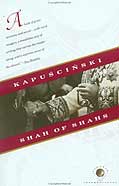« The Facts Behind the Helsinki Roccamatios - Yann Martel | Home | Charlie Wilson's War - George Crile »
March 5, 2005
Shah of Shahs - Ryszard Kapuscinski

In Shah of Shahs Polish journalist Ryszard Kapuscinski turns his focus to the former Shah of Iran, the CIA supported dictator whose oppressive regime led to the revolution that took Americans hostage in their own embassy, caused the shah's exile, and resulted in the fundamentalist Islamic government that runs Iran today. Kapuscinski published this book in 1982, just a few years after the revolution. In his unique style Kapuscinski weaves history, stories of individuals, and his own observations and interpretations.
It seems as if in every oppressive regime, there is a police authority, a spy network that detains and tortures anyone suspected of not being loyal to the ruling regime. In Iran, that group of thugs was the Savak.
And Savak meant, above all, torture of the most horrible kind. They would kidnap a man as he walked along the street, blindfold him, and lead him straight into the torture chamber without asking a single question. There they would start in with the whole macabre routine—breaking bones, pulling out fingernails, forcing hands into hot ovens, drilling into the living skull,, and scores of other brutalities—in the end, when the victim had gone mad with pain and become a smashed, bloody mass, they would proceed to establish his identity. Name? Address? What have you been saying about the Shah? Come on, what have you been saying? And you know, he might not have said anything, ever. He might have been completely innocent. But to Savak, that was nothing, being innocent. This way everyone will be afraid, innocent and guilty alike, everyone will feel the intimidation, no one will feel safe.
In such a society, husbands and wives would go years without ever mentioning a thing about the government. You never knew what someone might say under torture, so it was safest not to ever mention anything that could be taken as dissatisfaction with the government. If a Savak agent overheard you complaining that the heat of the day was "oppressive" they would interpret that as complaining against the Shah and cart you off to jail.
The first two thirds of Shah of Shahs focuses more on the historical background leading up to the revolution. The last third concerns the revolution itself. In this section Kapuscinski offers reflections on the nature of revolutions; he has experienced first hand dozens of them around the world. One observation of note is that the people who come to power after the revolution aren't the same people who brought the regime down. In the case of Iran, people with a democratic vision took the greatest risks, suffered the most oppression, and caused the downfall of the Shah. Iran however could not support a democracy, as the majority of the population preferred Islamic fundamentalism. So ultimately that's what they got in the Ayatollah Khomeini.
Well written, as all Kapuscinski's books, and essential reading for anyone truly interested in current Middle Eastern conflict.
Other Ex Libris reviews of works by Kapuscinski:
The Shadow of the Sun
Imperium
Posted by elise at 6:46 PM
to History